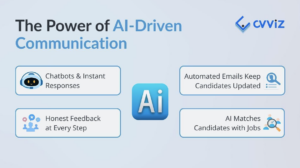In today’s competitive job market, finding the right candidate for a job opening can be like searching for a needle in a haystack. Recruiters are inundated with a sea of resumes, and manually sifting through each can be time-consuming and tedious. This is where resume parsing comes to the rescue. This blog will delve into resume parsing, discussing what it is, how it’s implemented using deep learning, its significance in modern recruitment, and its role in Applicant Tracking Systems (ATS).

What is Resume Parsing?
Resume parsing, or CV parsing, is a technology-driven solution that extracts and organizes essential information from resumes or CVs (Curriculum Vitae).
The primary goal of resume parsing is to convert unstructured data in resumes into a structured format that is easier to manage and analyze.
Resume parsers utilize Natural Language Processing (NLP) techniques, deep learning and machine learning algorithms, and pattern recognition to break down resumes into distinct data points.
These data points typically include the following –
A. Personal Information
- Candidate’s name
- Contact information like phone number, email address
- Physical Address
- Qualification or Educational details
B. Work Details
- Total years of experience
- Skills
- Previous employers
- Duration of employment
- Work summary
C. Educational Details
- Certifications done
- Degrees
- College or University
D. Other Details
- Patents and publications
- Languages known
- Visa details
Once you extract the above information using resume parsing, you could use various filters to automate the initial screening of candidates, saving time and reducing human errors.
We have an advantage with resume parsing. But how do we implement a resume parser?
There are two ways you could implement resume parsing.
- Rule-based resume parser
- Deep learning / NLP-based parser
Traditionally rule-based resume parsers were popular and effective. They would use methods like regular expressions and lookups to extract information. However, it had limitations. They need to be constantly updated for various resume formats.
However, with the rise of AI in recruitment, we can now use NLP for resume parsing.
Resume parsing with AI has proven to be more accurate. It also allows you to extract more information compared to a rule-based parser.
So, let’s look at how to use NLP for resume parsing.
How to Implement Resume Parsing Using Deep Learning?
Implementing resume parsing with deep learning involves training models to recognize and extract information from resumes.
Here’s a high-level overview of the steps involved:
a. Data Collection: Gather a large dataset of resumes in various formats (PDF, Word, HTML, etc.) with labeled or annotated data points (e.g., name, email, skills).
b. Data Preprocessing: Clean and preprocess the data, including text cleaning, tokenization, and feature extraction. You might use libraries like spaCy or NLTK for this.
c. Model Selection: Choose a deep learning architecture suitable for NLP tasks, such as recurrent neural networks (RNNs), convolutional neural networks (CNNs), or transformer-based models like BERT or GPT.
d. Training: Train the selected model on the labeled resume dataset. The model learns to identify and extract relevant information from resumes.
e. Evaluation: Assess the model’s performance using precision, recall, and F1-score metrics. Fine-tune the model as needed to improve accuracy.
f. Deployment: Integrate the trained model into a resume parsing software, tool, or API for recruitment.
So, the next question is how traditional, rule-based resume parsing differs from resume parsing with AI.
Let’s compare the two.
Rule-Based Resume Parsing vs. Resume Parsing With AI
Traditional Rule-Based Resume Parsing
- Rule-Based Approach: Traditional parsers rely on predefined rules and patterns to extract information from resumes. These rules are typically based on keywords, formatting, and structure. For example, a parser might look for keywords like “education,” “experience,” or “skills” to identify relevant sections.
- Limited Flexibility: Traditional parsers can struggle with resumes that deviate from standard formats or contain unconventional information structures. They may require constant updates to adapt to changes in resume styles and job market trends.
- Scalability: Traditional parsers can work well for smaller volumes of resumes but may struggle when processing a large number of documents. The manual creation and maintenance of rules can become time-consuming as the dataset grows.
- Accuracy: Accuracy depends heavily on the quality and completeness of the rule set. If the rules are not well-defined or updated regularly, there is a risk of missing important information or generating false positives.
Resume Parser Built Using NLP or AI
- Machine Learning-Based Approach: Resume parsers built with deep learning or AI leverage machine learning algorithms, such as neural networks, to extract information from resumes. These systems learn from data, which makes them more adaptable and capable of handling various resume formats.
- Flexibility: AI-based parsers can handle a wide range of resume formats, languages, and structures, making them more adaptable to the changing job market. They can identify information contextually, reducing the reliance on rigid rules.
- Scalability: Deep learning-based parsers can efficiently process large volumes of resumes, making them suitable for high-demand scenarios, such as recruitment agencies or large corporations.
- Accuracy: AI-based parsers can achieve high accuracy levels, as they continuously learn and improve from the data they process. They can also handle context and understand synonyms, reducing the chances of missing relevant information.
- Semantic Understanding: Some AI-based parsers can not only extract information but also understand the semantic meaning behind the content. For example, they can determine the relevance of a particular skill or experience to a job posting.
- Customization: AI-based parsers can be fine-tuned and customized to specific industries or job roles, improving their relevance and accuracy for specialized hiring needs.
You can expect many AI recruiting software to use an NLP-based resume parser.
How Resume Parsing Technology Helps Recruitment
Resume parsing technology brings numerous advantages to the recruitment process:
- Time Efficiency: Automates the initial screening of resumes, allowing recruiters to focus on more strategic tasks.
- Reduced Bias: If you can extract correct information using a resume parser, you can also hide the same information from the resume like name, location, etc. This will help you reduce biases in the hiring process.
- Improved Matching: Matches candidate skills and qualifications with job requirements more accurately.
- Consistency: Provides consistent and standardized data for easy comparison between candidates. This could be a handy feature for recruitment agencies where they want to share candidate profiles with their customers.
- Scalability: Handles bulk resume parsing efficiently, making it suitable for organizations with high volumes of job applications.
To avail maximum benefits of resume parsing, one must integrate it with the Applicant Tracking System(ATS). A resume parser may extract various information from the CV, but, how you use that information matters more.
For example, you may extract a name from the resume but what you do next with it is equally important. You can automate email communication where you address to candidate with the first name. Such automation adds value to your hiring process. Hence, integrating a resume parser into ATS can be a game changer.
A resume parser can be integrated into an ATS with resume parser API. Sometimes the ATS company may build the resume parser or sometimes they may decide to use an external CV parser.
Summary
Resume parsing has revolutionized the way recruiters handle resumes in the digital age. It harnesses the power of deep learning and NLP to transform unstructured data into structured information, making the recruitment process faster, more efficient, and less prone to bias.



